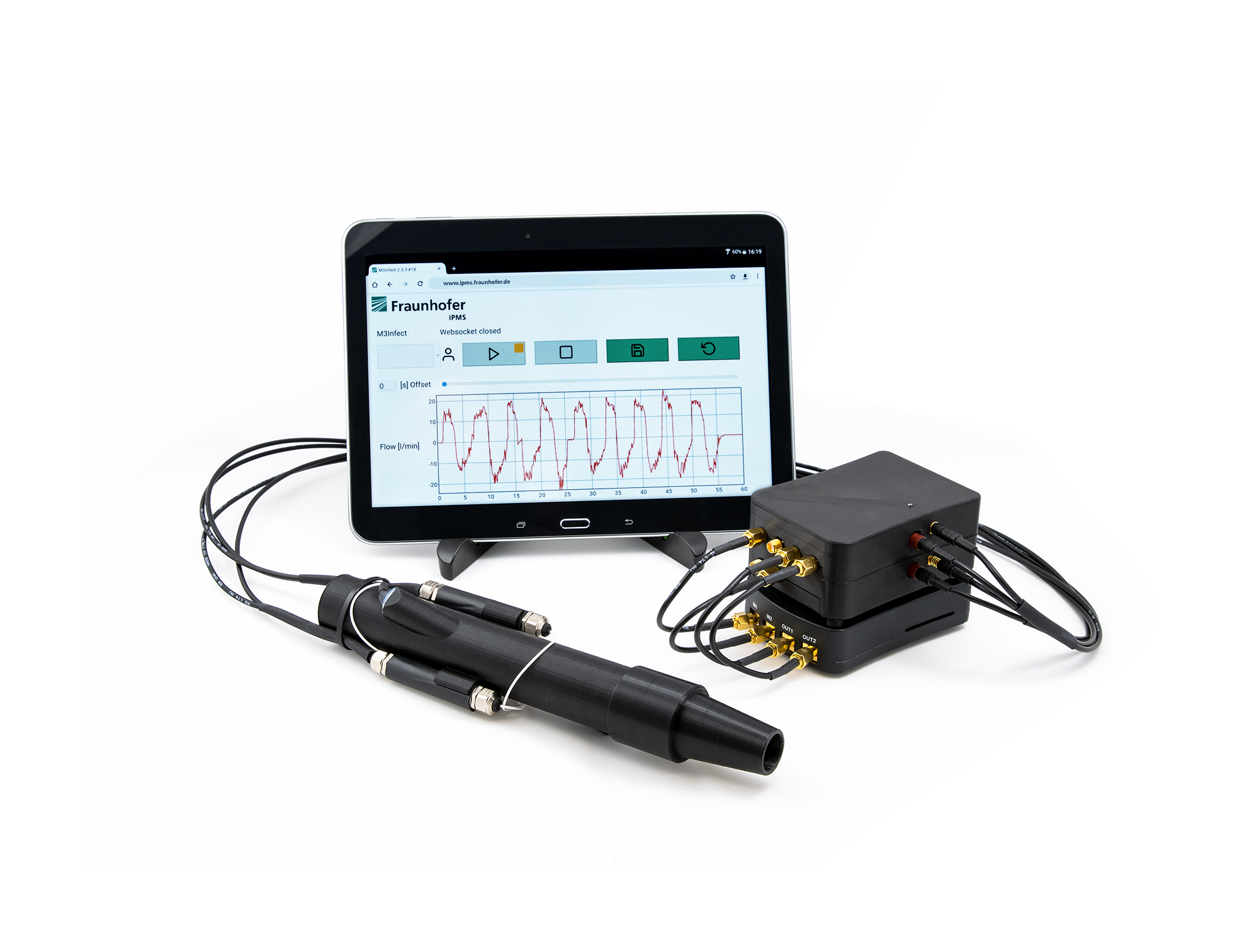Cluster project M3Infekt successfully completed
Decentralized monitoring of respiration in Covid 19 patients
The goal of the cluster project M3Infekt, initiated by the Fraunhofer-Gesellschaft, was to develop the technical basis for more comprehensive vital monitoring and care of Covid-19 patients outside of intensive care units, to relieve the burden on this critical infrastructure. Now that the project has been completed, the participating institutes have presented their results. The Fraunhofer Institute for Photonic Microsystems IPMS from Dresden made an important contribution to the development of a mobile and powerful spirometer with the help of its advanced CMUT ultrasonic sensor technology. The device for analyzing lung function is part of an AI-controlled, decentralized patient monitoring system and will be further developed in future projects.
The SARS-CoV-2 virus places high demands on medical diagnostics. Even mild courses can worsen acutely and cause severe symptoms. As a result, sudden deteriorations in health are often only detected with a time delay, and those affected are brought to a hospital too late. Therefore, continuous patient monitoring is recommended, especially for vulnerable populations. However, such monitoring has so far only been possible in intensive care units with the appropriate medical equipment and skilled personnel.
AI-controlled, decentralized patient monitoring in general hospital wards as well as in out-of-hospital settings could greatly relieve the burden on hospitals. The cluster project M3Infekt, initiated by the Fraunhofer-Gesellschaft in 2020, aimed to create the technical basis for mobile acquisition, analysis and fusion of relevant medical data. This will make valid diagnoses of condition and disease progression possible even remotely, and intensive care units will only be necessary in emergencies.
An important part of this remote monitoring is spirometric breath analysis using a MEMS-based ultrasonic system developed by Fraunhofer IPMS in Dresden. Spirometry is used to control the patient's airflow and thus to monitor breathing in general. In addition to other parameters of the cardiovascular system, such as heart rate, ECG or oxygen saturation, this allows reliable remote diagnosis of respiratory diseases such as COVID-19, asthma and COPD.
"The overarching goal was the continuous and mobile condition monitoring of patients with respiratory diseases in the (pre)clinical and nursing environment by recording physical respiratory parameters using a transportable sensor system," explains Dr. Sandro Koch, scientist at Fraunhofer IPMS. For this purpose, a concept for an ultrasonic spirometer consisting of a portable system for electronics and data processing as well as a disposable module for the sensor technology was developed. "The use of a disposable analysis module is an important criterion to prevent cross-contamination between patients," continues Koch.
For testing purposes, Fraunhofer IPMS developed the M3Spiro Rev03 spirometer system for breath analysis. It uses a 3D-printed disposable mouthpiece and a reusable polyactic (PLA) flow tube with embedded piezo-based ultrasonic sensors. "As part of a clinical study at the University Hospital Carl Gustav Carus in Dresden (UKDD), this respirometer was successfully tested on 33 persons," says Koch, who is already working with his team on the next generation of the spirometer system.
The use of capacitive micromechanical ultrasonic transducers (CMUTs), which enable a further reduction in the size of the spirometer with lower susceptibility to interference and higher accuracy, plays a special role here. "These miniaturized sensor structures, whose electrostatic principle of action enables the transmission and detection of ultrasound waves, are a new generation of ultrasonic transducers," explains Koch. They are manufactured using semiconductor technology processes, allowing great flexibility in sensor design with high precision and reproducibility in the manufacturing process for single- and multi-channel systems. "In addition, the manufacturing process and the CMUT elements do not contain toxic substances such as lead. The Fraunhofer IPMS capacitive transducers are therefore RoHS compliant and offer an alternative to previously used piezoelectric sensors," explains Koch.
While feasibility was successfully demonstrated in the tests conducted, there is still a need for further R&D in sensor optimization, system sizing and AI algorithms. "The challenges we have identified in the spirometer system will be addressed in a further development cycle to take the next step towards commercial exploitation," concludes Sandro Koch.
About Fraunhofer IPMS
The Fraunhofer Institute for Photonic Microsystems IPMS stands for applied research and development in the fields of intelligent industrial solutions, medical technology and improved quality of life. Our research focuses on miniaturized sensors and actuators, integrated circuits, wireless and wired data communication, and customized MEMS systems.
About the project M3Infect
The M3Infekt consortium, led by Fraunhofer IIS, consists of ten Fraunhofer institutes and four medical partners, whose various professional competencies complement each other in an interdisciplinary manner. The work was funded under the Fraunhofer-Gesellschaft's Internal Programs, grant number Anti-Corona 840259.
 Fraunhofer Institute for Photonic Microsystems
Fraunhofer Institute for Photonic Microsystems